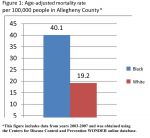Diabetes—unfortunately, it’s probably a familiar word to all of us, whether you have a family member who has the disease or you’re worried about developing it yourself. With more than 28 million people in the United States diagnosed with diabetes and 70 million who are prediabetic or at high-risk for developing the disease*, diabetes has become a national epidemic.
 |
Diabetes is of particular importance in our region because the largest increase in diabetes prevalence between 2000 and 2050 is expected to occur in Black men and women; the estimated risk for those individuals born in 2000 is roughly one in three. And, the death rate from diabetes among African Americans living in Allegheny County is twice the rate in Whites (see figure 1).
(In this article, we are talking about type 2 diabetes and not type 1 diabetes. Caused mainly by genetics, type 1 diabetes develops when the body’s immune system destroys the pancreatic cells that make insulin. Type 1 diabetes is a life-long disease that has no cure but can be managed.)
Let’s start with a brief description of what type 2 diabetes is. It is a disease characterized by the failure of the body’s pancreas to secrete an adequate amount of insulin, or decreased sensitivity to the insulin the pancreas does produce, and is caused by a combination of lifestyle and genetics. Insulin is a hormone that lowers the level of glucose (a type of sugar) in the blood and also helps glucose enter the body’s cells to be stored for energy or other uses. Having too much sugar in the bloodstream can damage the vessels that supply blood to the body’s organs, which can cause serious health problems, such as heart disease, blindness and eye problems, kidney disease, dental problems, complications with pregnancy and even limb amputations. Type 2 diabetes accounts for 90-95 percent of diabetes cases in the United States.
Diabetes sounds scary, but take a deep breath and know this: Type 2 diabetes can be avoidable, especially if you make the appropriate lifestyle interventions.
What can you do to take charge of your health? The key to avoiding type 2 diabetes is to control your blood sugar level, which can be done by watching what you eat, exercising and losing any excess weight. For many people, those three things are difficult. Many of us work a lot, put the needs of children or older parents ahead of our own and lack the time or resources to join a gym or get regular exercise.
Even with those barriers to eating healthfully and exercising regularly, registered dietitian Miriam Seidel, MS, with the Diabetes Prevention Programs at the University of Pittsburgh Diabetes Institute, has a few basic suggestions to possibly slow the onset of type 2 diabetes. They are:
1. Cut calories and decrease portion sizes. This includes watching what you’re drinking. Beverages like regular soda, juice, sweetened iced tea and others can add between 500-1,000 extra calories to your daily diet. Consider replacing those drinks with tap water. Portion size is very important, too; did you know that the recommended serving of lean meat or poultry is three ounces—the size of a deck of cards?
2. Increase your fruit and vegetable intake. They don’t even have to be fresh—frozen and some canned fruits and vegetables (fruits that aren’t canned in syrup) are ok. Consider shopping in the Strip District, where produce can be very affordable.
3. Increase physical activity. Start slowly, and work up to at least 30 minutes of moderately intensive physical activity every day. Your local library will have exercise DVDs and videos that make physical activity possible in your home even during our Pittsburgh winters.
4. Keep a food journal. Many people find that taking the time to note everything they eat helps them to see what they can cut out or to discover eating habits they can change.
These are just a few suggestions to take you down the path to avoiding type 2 diabetes (and to bettering your health in general). But, if you’re worried about type 2 diabetes, talk to your health care provider. Take charge of your health today. Be informed. Be involved.
*Centers for Disease Control and Prevention, National Diabetes Fact Sheet, 2011